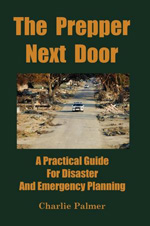In the last post we looked at “must have” prepper guns for defense. To celebrate turkey day, we’ll look at “must have” firearms for hunting. Most of us in America today, myself included, will celebrate with a store-bought turkey. The majority of Americans don’t hunt for their food anymore. None of it. When our country was first founded, most Americans would have raised their own turkey or hunted for one.
City & Suburban Preppers
For city and suburban preppers, hunting guns make little sense to me. I just don’t see us grabbing our 30-06 and trying to bag a buck. If we’re able to knock off squirrel with our 20 gauge, and not arrested for our efforts, that means 30,000 other people will be outside trying the same thing. In the city, the chances of success are vanishingly small, even for experienced hunters, if people are starving. The competition will be too great.
Driving “up North” to go hunting won’t be a good idea either. We’d need to leave our family and venture too far away in a serious crisis.
Police in many cities today have things called “shot trackers.” If you take a pot shot at a rabbit, you could be arrested if law and order is still present. Put this all together and my advice: If you’re a city prepper who plans to stay put, you don’t need any guns for hunting.
If you’re going to try to procure game in a cityscape, I’d focus on quiet weapons. An accurate spring piston air rifle could take small animals. A slingshot can work. If you developed skill with a bow, you could use it for larger game, but I doubt you’d find much big game. You can even bag birds with a bow if you use Flu Flu arrows.
Lesson: City preppers must store, grow, or raise their food. You won’t survive gigging frogs and hunting deer. You have no “must have” hunting guns.
Rural Preppers
If you’re fortunate enough to live where you might procure substantial amounts of meat by hunting, and you’re already a hunter, you almost certainly have the guns you need. Just stock up on cartridges for them.
As I write in the book, you’re well prepared to hunt every creature on earth with six weapons:
1) A 22 LR for small game. It could be a Ruger 10/22.
2) A varmint rifle for…varmints. This could be a 223 Remington bolt action or your AR-15. Serious varmint hunters like more esoteric calibers.
3) A larger game rifle (“deer rifle”). It could be a bolt action in 308 Winchester, 30-06, 7×57, or any of several dozen other calibers. Many experienced shooters/hunters love the 7mm Remington Magnum.
4) A “dangerous game” rifle, perhaps needed if you live in Africa. The 375 H&H Magnum is a standard choice. The 458 Winchester Magnum is another. If you live in Alaska and want a firearm for large bear, the 338 Winchester magnum is good. Many would consider the 30-06 adequate for everything in North America, including the largest bear.
5) A lightweight 20 gauge shotgun for upland game.
6) A 12 gauge shotgun for ducks, pheasants, turkey, or just about anything else.
If you have a gun representing each of those six groups, you’re prepared to hunt anything anywhere on earth and be appropriately armed. If you want to cut your hunting battery down, most of us don’t need a 20 gauge. It’s handy, but anything it can do, a 12 gauge can do too.
A “dangerous game” rifle isn’t needed by most of us. There aren’t too many rhino running around in Minneapolis, Minnesota. Very few lions charge people in Dallas, Texas. The varmint rifle can be skipped too.
For most rural preppers who see hunting as viable, there are three “must have” hunting guns: a 22 LR, a 12 gauge shotgun, and a big game rifle. You’re pretty much set to hunt anything in North America with those three weapons.
For a 22 LR rifle, it’s good to add a sling for carry (& stability in shooting, if you’ve been taught to use one for that). It’s good to have a low power scope. 4x is good. It’s much easier to aim with a scope than with iron sights. Toss in a few boxes of 22 Long CB caps which are extremely quite from a rifle barrel.
The 12 gauge shotgun probably should have a polychoke or choke tubes. A good barrel length is 24″ to 26.” Goose hunters might like 30″ barrels and turkey hunters stubby barrels, but if you can only have one barrel, you’ll need to compromise on length.
For most shotgunning, a large front sight bead is appropriate.
In addition to stocking birdshot, pack away a few boxes of rifled slugs, which are quite deadly for hunting deer and bear. If you want to use your shotgun for deer and bear, you can purchase a scope mount for it and get a low power (2x) scope. Putting a scope on a shotgun doesn’t make sense to some, but it helps in aiming. While great rifle shooters talk about minute of angle accuracy, shotgun slug shooters talk in terms of “minute of paper plate” accuracy!
The deer rifle should be set up like the 22. It needs a sling and a scope. A 2-7x variable scope is a good choice. For reliability and ease of maintenance, I’d go with a bolt action. The most popular calibers are the 308 Winchester and the 30-06, but any caliber you like is good, as long as you stock up on ammo for it.
These are my choices for “must have” hunting guns. What choices would you make?
